
A kinetic energy penetrator (KEP), also known as long-rod penetrator (LRP), is a type of ammunition designed to penetrate vehicle armour using a flechette-like, high-sectional density projectile. Like a bullet or kinetic energy weapon, this type of ammunition does not contain explosive payloads and uses purely kinetic energy to penetrate the target. Modern KEP munitions are typically of the armour-piercing fin-stabilized discarding sabot (APFSDS) type.

A bullet is a kinetic projectile, a component of firearm ammunition that is shot from a gun barrel. They are made of a variety of materials, such as copper, lead, steel, polymer, rubber and even wax; and are made in various shapes and constructions, including specialized functions such as hunting, target shooting, training and combat. Bullets are often tapered, making them more aerodynamic. Bullet size is expressed by weight and diameter in both imperial and metric measurement systems. Bullets do not normally contain explosives but strike or damage the intended target by transferring kinetic energy upon impact and penetration.

A cartridge or a round is a type of pre-assembled firearm ammunition packaging a projectile, a propellant substance and an ignition device (primer) within a metallic, paper, or plastic case that is precisely made to fit within the barrel chamber of a breechloading gun, for the practical purpose of convenient transportation and handling during shooting. Although in popular usage the term "bullet" is often informally used to refer to a complete cartridge, it is correctly used only to refer to the projectile.
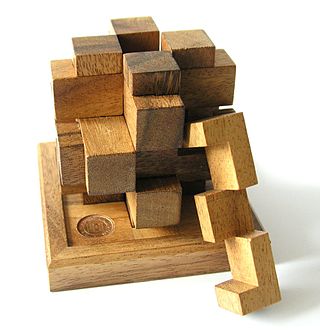
A mechanical puzzle is a puzzle presented as a set of mechanically interlinked pieces in which the solution is to manipulate the whole object or parts of it. While puzzles of this type have been in use by humanity as early as the 3rd century BC, one of the most well-known mechanical puzzles of modern day is the Rubik's Cube, invented by the Hungarian architect Ernő Rubik in 1974. The puzzles are typically designed for a single player, where the goal is for the player to see through the principle of the object, rather than accidentally coming up with the right solution through trial and error. With this in mind, they are often used as an intelligence test or in problem solving training.

The term boot refers to a family of instruments of torture and interrogation variously designed to cause crushing injuries to the foot and/or leg. The boot has taken many forms in various places and times. Common varieties include the Spanish boot and the Malay boot. One type was made of four pieces of narrow wooden board nailed together. The boards were measured to fit the victim's leg. Once the leg was enclosed, wedges would be hammered between the boards, creating pressure. The pressure would be increased until the victim confessed or lost consciousness. Newer variants have included iron vises—sometimes armed with spikes—that squeezed feet and metal frames employed red-hot. John Spreul is reported to have been tortured with two different boots. In general, the boot was a mechanically-clever torture device and was widely employed throughout Europe to extract information.

P. T. Selbit (1881–1938) was an English magician, inventor and writer who is credited with being the first person to perform the illusion of sawing a woman in half. Among magicians he was known for his inventiveness and entrepreneurial instinct and he is credited with creating a long list of successful stage illusions.
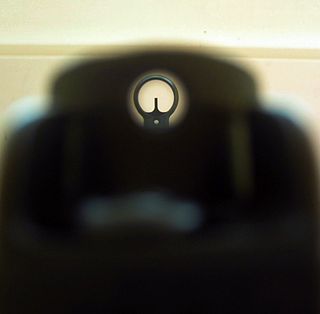
Iron sights are a system of physical alignment markers used as a sighting device to assist the accurate aiming of ranged weapons, or less commonly as a primitive finder sight for optical telescopes. The earliest sighting device, it relies completely on the viewer's naked eye, and is distinctly different to optical sights such as telescopic sights, reflector (reflex) sights, holographic sights and laser sights, which make use of optical manipulation and/or active illumination, as well as the newer optoelectronics, which use digital imaging and even incorporate augmented reality.

A keg is a small barrel.
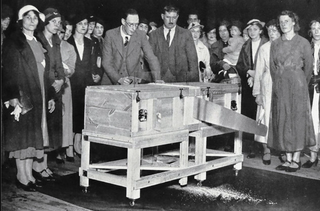
Sawing a woman in half is a generic name for a number of stage magic tricks in which a person is apparently cut or divided into two or more pieces.

The electric upright bass (EUB) is an instrument that can perform the musical function of a double bass. It requires only a minimal or 'skeleton' body to produce sound because it uses a pickup and electronic amplifier and loudspeaker. Therefore, a large resonating structure is not required to project the sound into the air. This minimal body greatly reduces the bulk and weight of the instrument. EUBs must always be connected to an amplifier and speaker cabinet to produce an adequate audible sound. The EUB retains enough of the features of the double bass so that double bass players are able to perform on it.

Metal Gear Acid 2, is a turn-based collectible card stealth game developed by Kojima Productions and published by Konami for the PlayStation Portable in 2005. A Java ME version for mobile phones was released by Glu Mobile in 2008 titled Metal Gear Acid 2 Mobile.

Metal Gear are the mecha in the Metal Gear series. In the series, a Metal Gear is a bipedal nuclear weapons-equipped tank. The Metal Gears are typically autonomous nuclear launch platforms which the player must destroy to save the world and complete the game. Often, confronting the latest Metal Gear model is one of the final challenges of each game.
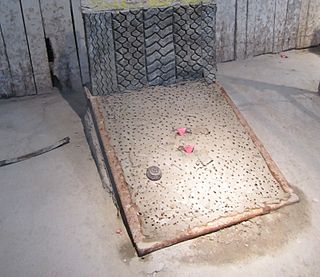
Tejo, also known, to a lesser degree, as turmequé, is a traditional throwing sport in Colombia. It is characteristic for its use of small targets containing gunpowder, which explode on impact.

The Radium Girl is a stage illusion of the classic type involving a female assistant in a large box and is probably best categorised as a penetration or restoration-type illusion. Its origins and history are much less well documented than those of many other "big box" illusions but some sources indicate it might be one of the earliest examples of that type of trick. References and picture captions indicate it was the creation of British magician and designer Val Walker.

The Devil's Torture Chamber is a magic stage illusion of the classic type involving a female magician's assistant in a large box and is probably best categorised as a penetration or restoration-type illusion.
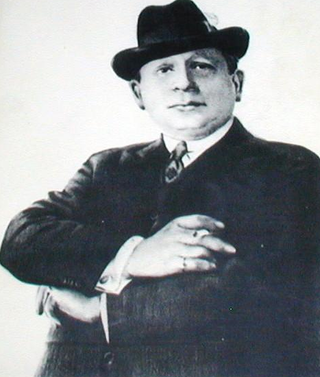
Horace Goldin was a stage magician who was noted for his rapid presentation style and who achieved international fame with his versions of the sawing a woman in half illusion.
A magician's assistant is a performer in a magic act who is not billed as the magician or principal name in the act. The role of an assistant can include holding the props that are used by a magician, shifting props onto and off the stage, and serving as a living prop in illusions that involve manipulation of the human body. Other aspects of the role can include dancing or acting as visual ornamentation, sometimes for simple aesthetic purposes and sometimes to misdirect audience attention. The figure of the glamorous female assistant has become a stereotype or icon in art, popular media and fiction.
The following are terms related to firearms and ammunition topics.

A levitation illusion is one in which a magician appears to defy gravity by making an object or person float in the air. The subject may appear to levitate unassisted, or it may be performed with the aid of another object in which case it is termed a "suspension".
The 3.7 cm Tankabwehrkanone 1918 in starrer Räderlafette or 3.7 cm TAK 1918, was an anti-tank gun built by Rheinmetall for the Imperial German Army near the end of the First World War. This was the world's first AT gun ever built that was purpose-designed for the role of an anti-tank gun.

















